Backlinks are really important to SEO. When a webpage links to your website or any webpage of your website, it is called a backlink. Google’s Page Rank algorithm used backlinks as primary criteria for evaluating a website. The more backings, the higher chances of better ranking in search. When SEO people started manipulating page rank by buying backlinks and creating backlinks unnaturally, Google shifted focus from backlinks to quality backlinks. It even rolled out Penguin update to penalize websites having bad backlinks that may be spammy or toxic. Google recommends only quality backlinks. This is the reason now SEOs focus on quality backlinks in place of the number of backlinks.
Quality backlinks
You should first know what backlink is actually be seen as quality backlink.
A quality backlink is a backlink that comes from a reputed and trusted website. Some people also see backlinks from high Domain Authority websites as quality backlinks. I don’t think domain authority should be criteria, Obviously, backlinks from high domain authority sites have more values but not all websites with low domain authority are spammy. What I believe is that a backlink from a good website is a quality backlink. A backlink from a high DA website will benefit more than a backlink from a low DA website. So, the focus should be on building links from high DA websites.
What are Toxic Backlinks
There could be several definitions depending on how people explain it. But what could be better than Google’s definition. So, here is now Google defined toxic or bad backlinks.
“In some circumstances, incoming links can affect Google’s opinion of a page or site. For example, you or an SEO that you’ve hired may have built bad links to your site via paid links or other link schemes that violate our quality guidelines.”
Google also confirms that you should worry only if your website has large number of toxic backlinks.
What kinds of backlinks Google may consider toxic links?
Mostly Google considers links from link networks and web directories. Links from websites that have received manual penalties may also be considered toxic links.
Google doesn’t recommend unnatural link building. The search giant also says that participating in link schemes violates the Webmaster Guidelines. If you have too many links from spam websites, your website will get manual action from Google. In the worst case, Google may also deindex your website.
Google knows that you cannot stop someone from linking your website. Sometimes your competitors may do a negative SEO campaign against your website. So, Google has created a disavow tool where you can tell Google what toxic or bad backlinks should be considered. But the real problem is how to identify these spammy, bad, or toxic backlinks.
How to identify spammy, bad or toxic backlinks.?
I personally use and recommend SEMrush. SEMrush comes with a backlink audit tool that can analyze all your backlinks and then tell you the overall Toxicity score of your domain.
Here’s a snapshot of how Backlink Audit report of SEMrush looks.
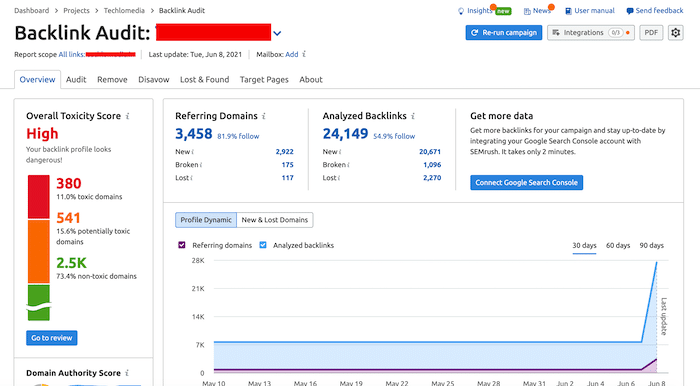
You can see that 11% of linking domains are marked as toxic. That’s not a big deal. If toxic domains account for a major portion of backlinks, your website will surely be at risk of a manual penalty.
Click on Toxic backlink count and it will open the list of all toxic backlinks, linking page, Toxicity screen and quick actions buttons.

You should always spend some time and manually review these backlinks to confirm if it looks spammy. Toxicity Score helps a lot. If you are confirming that the link is toxic, you should move it to Disavow list. For moving to Disavow list, click on the third button in the Actions button group at the right.
After you have reviewed all backlinks, it is the time to review the list of Backlinks you moved to Disavow list. Use the tabs above to visit Disavow list.
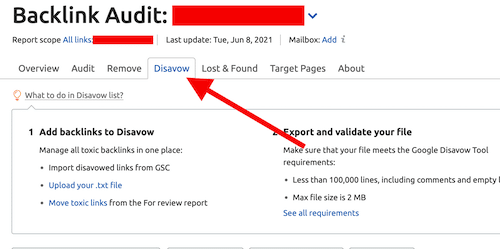
As I moved the whole domain to disavow list, it is showing the domain list here. Now you need to click on the Export to TXT button to download this list as a text file.
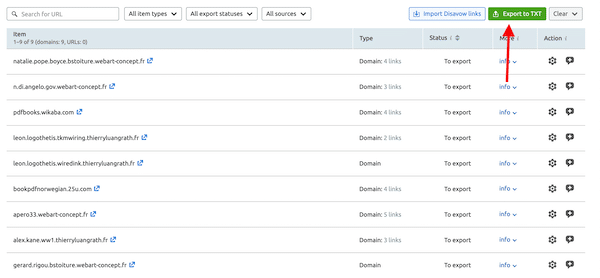
Your domains’s Disavow file is ready. You need to get rid of backlinks form the domains added to the Disavow file.
How to get rid of Spammy, bad or toxic backlinks?
Now you can either try to contact website owners for removing the backlink or use Google. Most of the spam websites lack any contact information. So, there is no way you can ask them to remove the backlink. Google Understands this. This is the reason it has created a Google Disavow Tool. Now you also understand why SEMrush was using Disavow term. In Google Disavow Tool, you can upload the list of backlinks or domains you want Google to not consider while evaluating your link profile. Google will make sure actions of these spam websites do not negatively affect your website. Incoming links from these websites won’t harm you.
You can only use Google Disavow Tool if you have verified your domain in Google Search Console. I assume you have your domain verified there. So, procedding with further process.
Here’s how Google Disavow Tool looks.
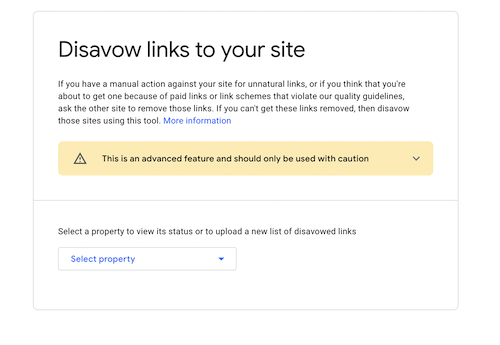
Select the website property for which you want to upload disavow list. The Click on Upload disavow list button. Upload the text file you downloaded from SEMrush.
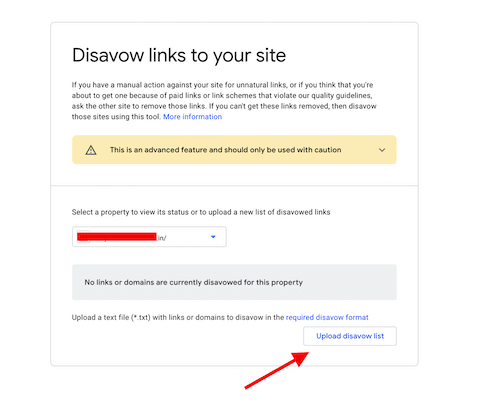
Google will take sometime in checking this list and will take action accordingly.
This was the recommended way of getting rid of toxic or bad backlink
Wrap Up
I always recommend people focus on content and relationship building. If you post good content and provide value to your readers and visitors, your website will automatically attract quality and organic backlinks. You won’t have to put much effort. As I also explained that not all spammy backlinks are paid backlinks. Sometimes your competitor may try to harm you by doing negative backlinking to your website. Some spammy websites automatically link to your domain. So, it is important to keep doing backlink audit 3-4 times a year to avoid any risk to your website’s organic traffic. Until Google isn’t slapping a manual penalty, your website is safe. But it is better to have precautions rather than going for treatment after falling sick. So, a backlink audit is important.
SEMrush is my recommendation to all bloggers and website owners. This single tool can help you a lot.

Leave a comment